Testhyperlink123: Difference between revisions
Jump to navigation
Jump to search
Guptareeya53 (talk | contribs) No edit summary |
Guptareeya53 (talk | contribs) No edit summary |
||
| Line 4: | Line 4: | ||
'''glycan_dictionary_accession''' : GSD000087 <br> | '''glycan_dictionary_accession''' : GSD000087 <br> | ||
'''glytoucan_accession ''' : [https://www.glygen.org/glycan/G00061MO G00061MO] <br> | '''glytoucan_accession ''' : [https://www.glygen.org/glycan/G00061MO G00061MO] <br> | ||
'''term_in_sentence''' : Results of TLC immunostaining of neutral glycolipids from the cDNA-transfected cells also supported the identity of the newly synthesized component as globoside. [PMID: | '''term_in_sentence''' : Results of TLC immunostaining of neutral glycolipids from the cDNA-transfected cells also supported the identity of the newly synthesized component as globoside. [PMID:[https://pubmed.ncbi.nlm.nih.gov/10993897 10993897]] <br> | ||
'''publication''' : [https://pubmed.ncbi.nlm.nih.gov/10993897 10993897] <br> | '''publication''' : [https://pubmed.ncbi.nlm.nih.gov/10993897 10993897] <br> | ||
'''definition''' : <br> | '''definition''' : <br> | ||
| Line 20: | Line 20: | ||
'''glycan_dictionary_accession''' : GSD000088 <br> | '''glycan_dictionary_accession''' : GSD000088 <br> | ||
'''glytoucan_accession ''' : [https://www.glygen.org/glycan/G00061MO G00061MO] <br> | '''glytoucan_accession ''' : [https://www.glygen.org/glycan/G00061MO G00061MO] <br> | ||
'''term_in_sentence''' : Here we report that PUGNAc treatment provokes globotetraosylceramide (Gb4Cer) accumulation in human umbilical vein endothelial cells (HUVEC).[PMID: | '''term_in_sentence''' : Here we report that PUGNAc treatment provokes globotetraosylceramide (Gb4Cer) accumulation in human umbilical vein endothelial cells (HUVEC).[PMID:[https://pubmed.ncbi.nlm.nih.gov/28392398 28392398]] <br> | ||
'''publication''' : [https://pubmed.ncbi.nlm.nih.gov/28392398 28392398]|[https://pubmed.ncbi.nlm.nih.gov/25787850 25787850]|[https://pubmed.ncbi.nlm.nih.gov/23471986 23471986]|[https://pubmed.ncbi.nlm.nih.gov/2559078 2559078]|[https://pubmed.ncbi.nlm.nih.gov/32455599 32455599]|[https://pubmed.ncbi.nlm.nih.gov/2663859 2663859]|[https://pubmed.ncbi.nlm.nih.gov/32796033 32796033]|[https://pubmed.ncbi.nlm.nih.gov/3517161 3517161]|[https://pubmed.ncbi.nlm.nih.gov/20082214 20082214]|[https://pubmed.ncbi.nlm.nih.gov/30853699 30853699]|[https://pubmed.ncbi.nlm.nih.gov/15279935 15279935]|[https://pubmed.ncbi.nlm.nih.gov/26104834 26104834]|[https://pubmed.ncbi.nlm.nih.gov/20732996 20732996]|[https://pubmed.ncbi.nlm.nih.gov/30224239 30224239]|[https://pubmed.ncbi.nlm.nih.gov/31142708 31142708]|[https://pubmed.ncbi.nlm.nih.gov/30338271 30338271]|[https://pubmed.ncbi.nlm.nih.gov/25033755 25033755]| | '''publication''' : [https://pubmed.ncbi.nlm.nih.gov/28392398 28392398]|[https://pubmed.ncbi.nlm.nih.gov/25787850 25787850]|[https://pubmed.ncbi.nlm.nih.gov/23471986 23471986]|[https://pubmed.ncbi.nlm.nih.gov/2559078 2559078]|[https://pubmed.ncbi.nlm.nih.gov/32455599 32455599]|[https://pubmed.ncbi.nlm.nih.gov/2663859 2663859]|[https://pubmed.ncbi.nlm.nih.gov/32796033 32796033]|[https://pubmed.ncbi.nlm.nih.gov/3517161 3517161]|[https://pubmed.ncbi.nlm.nih.gov/20082214 20082214]|[https://pubmed.ncbi.nlm.nih.gov/30853699 30853699]|[https://pubmed.ncbi.nlm.nih.gov/15279935 15279935]|[https://pubmed.ncbi.nlm.nih.gov/26104834 26104834]|[https://pubmed.ncbi.nlm.nih.gov/20732996 20732996]|[https://pubmed.ncbi.nlm.nih.gov/30224239 30224239]|[https://pubmed.ncbi.nlm.nih.gov/31142708 31142708]|[https://pubmed.ncbi.nlm.nih.gov/30338271 30338271]|[https://pubmed.ncbi.nlm.nih.gov/25033755 25033755]|[https://pubmed.ncbi.nlm.nih.gov/30413389 30413389]|[https://pubmed.ncbi.nlm.nih.gov/7104376 7104376]|[https://pubmed.ncbi.nlm.nih.gov/29866658 29866658]|[https://pubmed.ncbi.nlm.nih.gov/24983355 24983355]|[https://pubmed.ncbi.nlm.nih.gov/6794884 6794884]|[https://pubmed.ncbi.nlm.nih.gov/31361021 31361021]|[https://pubmed.ncbi.nlm.nih.gov/21740983 21740983]|[https://pubmed.ncbi.nlm.nih.gov/33168837 33168837]|[https://pubmed.ncbi.nlm.nih.gov/31752441 31752441]|[https://pubmed.ncbi.nlm.nih.gov/28123520 28123520]|[https://pubmed.ncbi.nlm.nih.gov/29068380 29068380]|[https://pubmed.ncbi.nlm.nih.gov/24841197 24841197]|[https://pubmed.ncbi.nlm.nih.gov/27932383 27932383]|[https://pubmed.ncbi.nlm.nih.gov/28535204 28535204]|[https://pubmed.ncbi.nlm.nih.gov/31691795 31691795]|[https://pubmed.ncbi.nlm.nih.gov/27916888 27916888]|[https://pubmed.ncbi.nlm.nih.gov/27558838 27558838]|[https://pubmed.ncbi.nlm.nih.gov/10227680 10227680]|[https://pubmed.ncbi.nlm.nih.gov/26464281 26464281]|[https://pubmed.ncbi.nlm.nih.gov/22348006 22348006]|[https://pubmed.ncbi.nlm.nih.gov/22279060 22279060]|[https://pubmed.ncbi.nlm.nih.gov/25156739 25156739]|[https://pubmed.ncbi.nlm.nih.gov/32314902 32314902]|[https://pubmed.ncbi.nlm.nih.gov/22718629 22718629]|[https://pubmed.ncbi.nlm.nih.gov/23701631 23701631]|[https://pubmed.ncbi.nlm.nih.gov/23906628 23906628]|[https://pubmed.ncbi.nlm.nih.gov/8613382 8613382]|[https://pubmed.ncbi.nlm.nih.gov/23555772 23555772]|[https://pubmed.ncbi.nlm.nih.gov/20059899 20059899]|[https://pubmed.ncbi.nlm.nih.gov/7868240 7868240] <br> | ||
'''definition''' : An amino tetrasaccharide consisting of 2-acetamido-2-deoxy-β-D-galactopyranosyl, α-D-galactopyranosyl, β-D-galactopyranosyl, and β-D-glucopyranose units joined together in sequence by (1→3), (1→4), and (1→4) glycosidic linkages, respectively.[CHEBI:145578] <br> | '''definition''' : An amino tetrasaccharide consisting of 2-acetamido-2-deoxy-β-D-galactopyranosyl, α-D-galactopyranosyl, β-D-galactopyranosyl, and β-D-glucopyranose units joined together in sequence by (1→3), (1→4), and (1→4) glycosidic linkages, respectively.[CHEBI:145578] <br> | ||
'''term_xref''' : GlycoMotif:GGM.000070|GlycoEpitope:EP0073|CID:[https://pubmed.ncbi.nlm.nih.gov/5288889 5288889]|CHEBI:145578|SugarBind_Ligand:18|MeSH:C024032<br> | '''term_xref''' : GlycoMotif:GGM.000070|GlycoEpitope:EP0073|CID:[https://pubmed.ncbi.nlm.nih.gov/5288889 5288889]|CHEBI:145578|SugarBind_Ligand:18|MeSH:C024032<br> | ||
| Line 37: | Line 37: | ||
'''glytoucan_accession ''' : [https://www.glygen.org/glycan/G00059MO G00059MO] <br> | '''glytoucan_accession ''' : [https://www.glygen.org/glycan/G00059MO G00059MO] <br> | ||
'''term_in_sentence''' : Defects in the gene encoding α-galactosidase A lead to accumulation of globotriaosylceramide (GL3) in various cell types.[PMID:[https://pubmed.ncbi.nlm.nih.gov/32127409 32127409]] <br> | '''term_in_sentence''' : Defects in the gene encoding α-galactosidase A lead to accumulation of globotriaosylceramide (GL3) in various cell types.[PMID:[https://pubmed.ncbi.nlm.nih.gov/32127409 32127409]] <br> | ||
'''publication''' : [https://pubmed.ncbi.nlm.nih.gov/32127409 32127409]|[https://pubmed.ncbi.nlm.nih.gov/28674962 28674962]|[https://pubmed.ncbi.nlm.nih.gov/30875019 30875019]| | '''publication''' : [https://pubmed.ncbi.nlm.nih.gov/32127409 32127409]|[https://pubmed.ncbi.nlm.nih.gov/28674962 28674962]|[https://pubmed.ncbi.nlm.nih.gov/30875019 30875019]|[https://pubmed.ncbi.nlm.nih.gov/30413389 30413389]|[https://pubmed.ncbi.nlm.nih.gov/31778662 31778662]|[https://pubmed.ncbi.nlm.nih.gov/31101366 31101366]|[https://pubmed.ncbi.nlm.nih.gov/24335674 24335674]|[https://pubmed.ncbi.nlm.nih.gov/31241709 31241709]|[https://pubmed.ncbi.nlm.nih.gov/24158513 24158513]|[https://pubmed.ncbi.nlm.nih.gov/28947349 28947349]|[https://pubmed.ncbi.nlm.nih.gov/31566927 31566927]|[https://pubmed.ncbi.nlm.nih.gov/28672034 28672034]|[https://pubmed.ncbi.nlm.nih.gov/31939530 31939530]|[https://pubmed.ncbi.nlm.nih.gov/29530250 29530250]|[https://pubmed.ncbi.nlm.nih.gov/27851774 27851774]|[https://pubmed.ncbi.nlm.nih.gov/26426881 26426881]|[https://pubmed.ncbi.nlm.nih.gov/25031264 25031264]|[https://pubmed.ncbi.nlm.nih.gov/29982630 29982630]|[https://pubmed.ncbi.nlm.nih.gov/24496231 24496231]|[https://pubmed.ncbi.nlm.nih.gov/29983334 29983334]|[https://pubmed.ncbi.nlm.nih.gov/28756410 28756410]|[https://pubmed.ncbi.nlm.nih.gov/27190352 27190352]|[https://pubmed.ncbi.nlm.nih.gov/29274327 29274327]|[https://pubmed.ncbi.nlm.nih.gov/29099167 29099167]|[https://pubmed.ncbi.nlm.nih.gov/28402705 28402705]|[https://pubmed.ncbi.nlm.nih.gov/23680766 23680766]|[https://pubmed.ncbi.nlm.nih.gov/28625968 28625968]|[https://pubmed.ncbi.nlm.nih.gov/26960552 26960552]|[https://pubmed.ncbi.nlm.nih.gov/26797827 26797827]|[https://pubmed.ncbi.nlm.nih.gov/22742555 22742555]|[https://pubmed.ncbi.nlm.nih.gov/27756537 27756537]|[https://pubmed.ncbi.nlm.nih.gov/31630715 31630715]|[https://pubmed.ncbi.nlm.nih.gov/3827883 3827883]|[https://pubmed.ncbi.nlm.nih.gov/28384397 28384397]|[https://pubmed.ncbi.nlm.nih.gov/29523338 29523338]|[https://pubmed.ncbi.nlm.nih.gov/31010832 31010832]|[https://pubmed.ncbi.nlm.nih.gov/27195818 27195818]|[https://pubmed.ncbi.nlm.nih.gov/26661087 26661087]|[https://pubmed.ncbi.nlm.nih.gov/23093409 23093409]|[https://pubmed.ncbi.nlm.nih.gov/30879639 30879639]|[https://pubmed.ncbi.nlm.nih.gov/27081853 27081853]|[https://pubmed.ncbi.nlm.nih.gov/17409683 17409683]|[https://pubmed.ncbi.nlm.nih.gov/29921669 29921669]|[https://pubmed.ncbi.nlm.nih.gov/25575293 25575293]|[https://pubmed.ncbi.nlm.nih.gov/26291612 26291612]|[https://pubmed.ncbi.nlm.nih.gov/23146289 23146289]|[https://pubmed.ncbi.nlm.nih.gov/25857295 25857295]|[https://pubmed.ncbi.nlm.nih.gov/26070511 26070511] <br> | ||
'''definition''' : Globotriaosylceramide is a type of globoside(glycosphingolipid) which is formed by alpha linkage of galactose to lactosylceramide. The reaction is catalyzed by enzyme A4GALT.[Wiki:Globotriaosylceramide] <br> | '''definition''' : Globotriaosylceramide is a type of globoside(glycosphingolipid) which is formed by alpha linkage of galactose to lactosylceramide. The reaction is catalyzed by enzyme A4GALT.[Wiki:Globotriaosylceramide] <br> | ||
'''term_xref''' : GlycoMotif:GGM.000068|GTC:G00059MO|GlycoEpitope:EP0071|CID:[https://pubmed.ncbi.nlm.nih.gov/5279515 5279515]|CHEBI:68485|MeSH:C018549|SugarBind_Ligand:27 <br> | '''term_xref''' : GlycoMotif:GGM.000068|GTC:G00059MO|GlycoEpitope:EP0071|CID:[https://pubmed.ncbi.nlm.nih.gov/5279515 5279515]|CHEBI:68485|MeSH:C018549|SugarBind_Ligand:27 <br> | ||
| Line 87: | Line 87: | ||
'''publication''' : [https://pubmed.ncbi.nlm.nih.gov/29618308 29618308]|[https://pubmed.ncbi.nlm.nih.gov/27491214 27491214]|[https://pubmed.ncbi.nlm.nih.gov/32867370 32867370]|[https://pubmed.ncbi.nlm.nih.gov/30030044 30030044]|[https://pubmed.ncbi.nlm.nih.gov/27499644 27499644]|[https://pubmed.ncbi.nlm.nih.gov/31097363 31097363]|[https://pubmed.ncbi.nlm.nih.gov/29100724 29100724]|[https://pubmed.ncbi.nlm.nih.gov/27402091 27402091]|[https://pubmed.ncbi.nlm.nih.gov/31852956 31852956]|[https://pubmed.ncbi.nlm.nih.gov/30389374 30389374]|[https://pubmed.ncbi.nlm.nih.gov/30988135 30988135]|[https://pubmed.ncbi.nlm.nih.gov/8786814 8786814]|[https://pubmed.ncbi.nlm.nih.gov/14533808 14533808]|[https://pubmed.ncbi.nlm.nih.gov/23370522 23370522]|[https://pubmed.ncbi.nlm.nih.gov/28192816 28192816]|[https://pubmed.ncbi.nlm.nih.gov/32692591 32692591]|[https://pubmed.ncbi.nlm.nih.gov/29106755 29106755]|[https://pubmed.ncbi.nlm.nih.gov/28833537 28833537]|[https://pubmed.ncbi.nlm.nih.gov/11339652 11339652]|[https://pubmed.ncbi.nlm.nih.gov/9728335 9728335]|[https://pubmed.ncbi.nlm.nih.gov/27270764 27270764]|[https://pubmed.ncbi.nlm.nih.gov/9714704 9714704]|[https://pubmed.ncbi.nlm.nih.gov/26175473 26175473]|[https://pubmed.ncbi.nlm.nih.gov/27018595 27018595]|[https://pubmed.ncbi.nlm.nih.gov/28615102 28615102]|[https://pubmed.ncbi.nlm.nih.gov/28974375 28974375]|[https://pubmed.ncbi.nlm.nih.gov/32951593 32951593]|[https://pubmed.ncbi.nlm.nih.gov/11462672 11462672]|[https://pubmed.ncbi.nlm.nih.gov/28955902 28955902]|[https://pubmed.ncbi.nlm.nih.gov/17192692 17192692]|[https://pubmed.ncbi.nlm.nih.gov/26538065 26538065]|[https://pubmed.ncbi.nlm.nih.gov/25421609 25421609]|[https://pubmed.ncbi.nlm.nih.gov/9572057 9572057]|[https://pubmed.ncbi.nlm.nih.gov/11596983 11596983]|[https://pubmed.ncbi.nlm.nih.gov/15264019 15264019]|[https://pubmed.ncbi.nlm.nih.gov/23236285 23236285]|[https://pubmed.ncbi.nlm.nih.gov/11596984 11596984]|[https://pubmed.ncbi.nlm.nih.gov/31261761 31261761]|[https://pubmed.ncbi.nlm.nih.gov/30113798 30113798]|[https://pubmed.ncbi.nlm.nih.gov/24391178 24391178]|[https://pubmed.ncbi.nlm.nih.gov/24309906 24309906]|[https://pubmed.ncbi.nlm.nih.gov/22224667 22224667]|[https://pubmed.ncbi.nlm.nih.gov/7980537 7980537]|[https://pubmed.ncbi.nlm.nih.gov/18272501 18272501]|[https://pubmed.ncbi.nlm.nih.gov/9006924 9006924]| <br> | '''publication''' : [https://pubmed.ncbi.nlm.nih.gov/29618308 29618308]|[https://pubmed.ncbi.nlm.nih.gov/27491214 27491214]|[https://pubmed.ncbi.nlm.nih.gov/32867370 32867370]|[https://pubmed.ncbi.nlm.nih.gov/30030044 30030044]|[https://pubmed.ncbi.nlm.nih.gov/27499644 27499644]|[https://pubmed.ncbi.nlm.nih.gov/31097363 31097363]|[https://pubmed.ncbi.nlm.nih.gov/29100724 29100724]|[https://pubmed.ncbi.nlm.nih.gov/27402091 27402091]|[https://pubmed.ncbi.nlm.nih.gov/31852956 31852956]|[https://pubmed.ncbi.nlm.nih.gov/30389374 30389374]|[https://pubmed.ncbi.nlm.nih.gov/30988135 30988135]|[https://pubmed.ncbi.nlm.nih.gov/8786814 8786814]|[https://pubmed.ncbi.nlm.nih.gov/14533808 14533808]|[https://pubmed.ncbi.nlm.nih.gov/23370522 23370522]|[https://pubmed.ncbi.nlm.nih.gov/28192816 28192816]|[https://pubmed.ncbi.nlm.nih.gov/32692591 32692591]|[https://pubmed.ncbi.nlm.nih.gov/29106755 29106755]|[https://pubmed.ncbi.nlm.nih.gov/28833537 28833537]|[https://pubmed.ncbi.nlm.nih.gov/11339652 11339652]|[https://pubmed.ncbi.nlm.nih.gov/9728335 9728335]|[https://pubmed.ncbi.nlm.nih.gov/27270764 27270764]|[https://pubmed.ncbi.nlm.nih.gov/9714704 9714704]|[https://pubmed.ncbi.nlm.nih.gov/26175473 26175473]|[https://pubmed.ncbi.nlm.nih.gov/27018595 27018595]|[https://pubmed.ncbi.nlm.nih.gov/28615102 28615102]|[https://pubmed.ncbi.nlm.nih.gov/28974375 28974375]|[https://pubmed.ncbi.nlm.nih.gov/32951593 32951593]|[https://pubmed.ncbi.nlm.nih.gov/11462672 11462672]|[https://pubmed.ncbi.nlm.nih.gov/28955902 28955902]|[https://pubmed.ncbi.nlm.nih.gov/17192692 17192692]|[https://pubmed.ncbi.nlm.nih.gov/26538065 26538065]|[https://pubmed.ncbi.nlm.nih.gov/25421609 25421609]|[https://pubmed.ncbi.nlm.nih.gov/9572057 9572057]|[https://pubmed.ncbi.nlm.nih.gov/11596983 11596983]|[https://pubmed.ncbi.nlm.nih.gov/15264019 15264019]|[https://pubmed.ncbi.nlm.nih.gov/23236285 23236285]|[https://pubmed.ncbi.nlm.nih.gov/11596984 11596984]|[https://pubmed.ncbi.nlm.nih.gov/31261761 31261761]|[https://pubmed.ncbi.nlm.nih.gov/30113798 30113798]|[https://pubmed.ncbi.nlm.nih.gov/24391178 24391178]|[https://pubmed.ncbi.nlm.nih.gov/24309906 24309906]|[https://pubmed.ncbi.nlm.nih.gov/22224667 22224667]|[https://pubmed.ncbi.nlm.nih.gov/7980537 7980537]|[https://pubmed.ncbi.nlm.nih.gov/18272501 18272501]|[https://pubmed.ncbi.nlm.nih.gov/9006924 9006924]| <br> | ||
'''definition''' : A branched amino tetrasaccharide consisting of the linear sequence β-D-GalNAc-(1→4)-β-D-Gal-(1→4)-β-D-Glc having a Neu5Ac residue attached to the galactose via an α-(2→3) linkage. Corresponds to the carbohydrate portion of ganglioside GM2.[CHEBI:59220] <br> | '''definition''' : A branched amino tetrasaccharide consisting of the linear sequence β-D-GalNAc-(1→4)-β-D-Gal-(1→4)-β-D-Glc having a Neu5Ac residue attached to the galactose via an α-(2→3) linkage. Corresponds to the carbohydrate portion of ganglioside GM2.[CHEBI:59220] <br> | ||
'''term_xref''' : GlycoMotif:GGM.000095|GTC:G79389NT|CID: | '''term_xref''' : GlycoMotif:GGM.000095|GTC:G79389NT|CID:45266845|CHEBI:59220|GlycoEpitope:EP0051|SugarBind_Ligand:39|KEGG:G00109|KEGG:G10351 <br> | ||
'''synonyms''' : <br> | '''synonyms''' : <br> | ||
'''function''' : <br> | '''function''' : <br> | ||
| Line 103: | Line 103: | ||
'''publication''' : [https://pubmed.ncbi.nlm.nih.gov/29376491 29376491]|[https://pubmed.ncbi.nlm.nih.gov/29747813 29747813]|[https://pubmed.ncbi.nlm.nih.gov/25613425 25613425]|[https://pubmed.ncbi.nlm.nih.gov/30318083 30318083]|[https://pubmed.ncbi.nlm.nih.gov/31526872 31526872]|[https://pubmed.ncbi.nlm.nih.gov/31004109 31004109]|[https://pubmed.ncbi.nlm.nih.gov/28019668 28019668]|[https://pubmed.ncbi.nlm.nih.gov/26434718 26434718]|[https://pubmed.ncbi.nlm.nih.gov/27313500 27313500]|[https://pubmed.ncbi.nlm.nih.gov/27539856 27539856]|[https://pubmed.ncbi.nlm.nih.gov/30111401 30111401]|[https://pubmed.ncbi.nlm.nih.gov/28544772 28544772]|[https://pubmed.ncbi.nlm.nih.gov/29407985 29407985]|[https://pubmed.ncbi.nlm.nih.gov/19364317 19364317]|[https://pubmed.ncbi.nlm.nih.gov/30190430 30190430]|[https://pubmed.ncbi.nlm.nih.gov/31297734 31297734]|[https://pubmed.ncbi.nlm.nih.gov/30091781 30091781]|[https://pubmed.ncbi.nlm.nih.gov/26043887 26043887]|[https://pubmed.ncbi.nlm.nih.gov/32183071 32183071]|[https://pubmed.ncbi.nlm.nih.gov/30665141 30665141]|[https://pubmed.ncbi.nlm.nih.gov/27873002 27873002]|[https://pubmed.ncbi.nlm.nih.gov/25801320 25801320]|[https://pubmed.ncbi.nlm.nih.gov/30209782 30209782]|[https://pubmed.ncbi.nlm.nih.gov/32378734 32378734]|[https://pubmed.ncbi.nlm.nih.gov/23050851 23050851]|[https://pubmed.ncbi.nlm.nih.gov/22768242 22768242]|[https://pubmed.ncbi.nlm.nih.gov/14993837 14993837]|[https://pubmed.ncbi.nlm.nih.gov/24934090 24934090]|[https://pubmed.ncbi.nlm.nih.gov/17638075 17638075]|[https://pubmed.ncbi.nlm.nih.gov/21518140 21518140]|[https://pubmed.ncbi.nlm.nih.gov/26102277 26102277]|[https://pubmed.ncbi.nlm.nih.gov/19759399 19759399]|[https://pubmed.ncbi.nlm.nih.gov/24502144 24502144]|[https://pubmed.ncbi.nlm.nih.gov/25303960 25303960]|[https://pubmed.ncbi.nlm.nih.gov/23564406 23564406]|[https://pubmed.ncbi.nlm.nih.gov/16636105 16636105]|[https://pubmed.ncbi.nlm.nih.gov/16491123 16491123]|[https://pubmed.ncbi.nlm.nih.gov/11259118 11259118]|[https://pubmed.ncbi.nlm.nih.gov/15102521 15102521]|[https://pubmed.ncbi.nlm.nih.gov/12724312 12724312]|[https://pubmed.ncbi.nlm.nih.gov/24985965 24985965]|[https://pubmed.ncbi.nlm.nih.gov/8496625 8496625]|[https://pubmed.ncbi.nlm.nih.gov/25403557 25403557]|[https://pubmed.ncbi.nlm.nih.gov/15690123 15690123]|[https://pubmed.ncbi.nlm.nih.gov/15939439 15939439]|[https://pubmed.ncbi.nlm.nih.gov/25893133 25893133]|[https://pubmed.ncbi.nlm.nih.gov/23591593 23591593]|[https://pubmed.ncbi.nlm.nih.gov/20634908 20634908]|[https://pubmed.ncbi.nlm.nih.gov/2004380 2004380]|[https://pubmed.ncbi.nlm.nih.gov/739008 739008]| <br> | '''publication''' : [https://pubmed.ncbi.nlm.nih.gov/29376491 29376491]|[https://pubmed.ncbi.nlm.nih.gov/29747813 29747813]|[https://pubmed.ncbi.nlm.nih.gov/25613425 25613425]|[https://pubmed.ncbi.nlm.nih.gov/30318083 30318083]|[https://pubmed.ncbi.nlm.nih.gov/31526872 31526872]|[https://pubmed.ncbi.nlm.nih.gov/31004109 31004109]|[https://pubmed.ncbi.nlm.nih.gov/28019668 28019668]|[https://pubmed.ncbi.nlm.nih.gov/26434718 26434718]|[https://pubmed.ncbi.nlm.nih.gov/27313500 27313500]|[https://pubmed.ncbi.nlm.nih.gov/27539856 27539856]|[https://pubmed.ncbi.nlm.nih.gov/30111401 30111401]|[https://pubmed.ncbi.nlm.nih.gov/28544772 28544772]|[https://pubmed.ncbi.nlm.nih.gov/29407985 29407985]|[https://pubmed.ncbi.nlm.nih.gov/19364317 19364317]|[https://pubmed.ncbi.nlm.nih.gov/30190430 30190430]|[https://pubmed.ncbi.nlm.nih.gov/31297734 31297734]|[https://pubmed.ncbi.nlm.nih.gov/30091781 30091781]|[https://pubmed.ncbi.nlm.nih.gov/26043887 26043887]|[https://pubmed.ncbi.nlm.nih.gov/32183071 32183071]|[https://pubmed.ncbi.nlm.nih.gov/30665141 30665141]|[https://pubmed.ncbi.nlm.nih.gov/27873002 27873002]|[https://pubmed.ncbi.nlm.nih.gov/25801320 25801320]|[https://pubmed.ncbi.nlm.nih.gov/30209782 30209782]|[https://pubmed.ncbi.nlm.nih.gov/32378734 32378734]|[https://pubmed.ncbi.nlm.nih.gov/23050851 23050851]|[https://pubmed.ncbi.nlm.nih.gov/22768242 22768242]|[https://pubmed.ncbi.nlm.nih.gov/14993837 14993837]|[https://pubmed.ncbi.nlm.nih.gov/24934090 24934090]|[https://pubmed.ncbi.nlm.nih.gov/17638075 17638075]|[https://pubmed.ncbi.nlm.nih.gov/21518140 21518140]|[https://pubmed.ncbi.nlm.nih.gov/26102277 26102277]|[https://pubmed.ncbi.nlm.nih.gov/19759399 19759399]|[https://pubmed.ncbi.nlm.nih.gov/24502144 24502144]|[https://pubmed.ncbi.nlm.nih.gov/25303960 25303960]|[https://pubmed.ncbi.nlm.nih.gov/23564406 23564406]|[https://pubmed.ncbi.nlm.nih.gov/16636105 16636105]|[https://pubmed.ncbi.nlm.nih.gov/16491123 16491123]|[https://pubmed.ncbi.nlm.nih.gov/11259118 11259118]|[https://pubmed.ncbi.nlm.nih.gov/15102521 15102521]|[https://pubmed.ncbi.nlm.nih.gov/12724312 12724312]|[https://pubmed.ncbi.nlm.nih.gov/24985965 24985965]|[https://pubmed.ncbi.nlm.nih.gov/8496625 8496625]|[https://pubmed.ncbi.nlm.nih.gov/25403557 25403557]|[https://pubmed.ncbi.nlm.nih.gov/15690123 15690123]|[https://pubmed.ncbi.nlm.nih.gov/15939439 15939439]|[https://pubmed.ncbi.nlm.nih.gov/25893133 25893133]|[https://pubmed.ncbi.nlm.nih.gov/23591593 23591593]|[https://pubmed.ncbi.nlm.nih.gov/20634908 20634908]|[https://pubmed.ncbi.nlm.nih.gov/2004380 2004380]|[https://pubmed.ncbi.nlm.nih.gov/739008 739008]| <br> | ||
'''definition''' : Ganglioside GM3 (d18:1/16:0) is a glycosphingolipid (ceramide and oligosaccharide)or oligoglycosylceramide with one or more sialic acids (i.e. n-acetylneuraminic acid) linked on the sugar chain. It is a component the cell plasma membrane which modulates cell signal transduction events. Gangliosides have been found to be highly important in immunology. Ganglioside GM3 carries a net-negative charge at pH 7.0 and is acidic. Gangliosides can amount to 6% of the weight of lipids from brain, but they are found at low levels in all animal tissuesGangliosides are glycosphingolipids. There are four types of glycosphingolipids, the cerebrosides, sulfatides, globosides and gangliosides. Gangliosides are very similar to globosides except that they also contain N-acetyl neuraminic acid (NANA) in varying amounts. The specific names for the gangliosides provide information about their structure. The letter G refers to ganglioside, and the subscripts M, D, T and Q indicate that the molecule contains mono-, di-, tri and quatra-sialic acid. The numbered subscripts 1, 2 and 3 refer to the carbohydrate sequence that is attached to the ceramide. In particular, 1 stands for GalGalNAcGalGlc-ceramide, 2 stands for GalNAcGalGlc-ceramide and 3 stands for GalGlc-ceramide. Deficiencies in lysosomal enzymes that degrade the carbohydrate portions of various gangliosides are responsible for a number of lysosomal storage diseases such as Tay-Sachs disease, Sandhoff disease, and GM1 gangliosidosis. The carbohydrate portion of the ganglioside GM1 is the site of attachment of cholera toxin, the protein secreted by Vibrio cholerae.[HMDB0004844] <br> | '''definition''' : Ganglioside GM3 (d18:1/16:0) is a glycosphingolipid (ceramide and oligosaccharide)or oligoglycosylceramide with one or more sialic acids (i.e. n-acetylneuraminic acid) linked on the sugar chain. It is a component the cell plasma membrane which modulates cell signal transduction events. Gangliosides have been found to be highly important in immunology. Ganglioside GM3 carries a net-negative charge at pH 7.0 and is acidic. Gangliosides can amount to 6% of the weight of lipids from brain, but they are found at low levels in all animal tissuesGangliosides are glycosphingolipids. There are four types of glycosphingolipids, the cerebrosides, sulfatides, globosides and gangliosides. Gangliosides are very similar to globosides except that they also contain N-acetyl neuraminic acid (NANA) in varying amounts. The specific names for the gangliosides provide information about their structure. The letter G refers to ganglioside, and the subscripts M, D, T and Q indicate that the molecule contains mono-, di-, tri and quatra-sialic acid. The numbered subscripts 1, 2 and 3 refer to the carbohydrate sequence that is attached to the ceramide. In particular, 1 stands for GalGalNAcGalGlc-ceramide, 2 stands for GalNAcGalGlc-ceramide and 3 stands for GalGlc-ceramide. Deficiencies in lysosomal enzymes that degrade the carbohydrate portions of various gangliosides are responsible for a number of lysosomal storage diseases such as Tay-Sachs disease, Sandhoff disease, and GM1 gangliosidosis. The carbohydrate portion of the ganglioside GM1 is the site of attachment of cholera toxin, the protein secreted by Vibrio cholerae.[HMDB0004844] <br> | ||
'''term_xref''' : GlycoMotif:GGM.000090|GTC:G91237TK|CID: | '''term_xref''' : GlycoMotif:GGM.000090|GTC:G91237TK|CID:5288424|CHEBI:59226|GlycoEpitope:EP0053|SugarBind_Ligand:35 <br> | ||
'''synonyms''' : <br> | '''synonyms''' : <br> | ||
'''function''' : Membrane stabilizer|Energy source|Energy storage|Molecular messenger:|Signaling molecule[HMDB0004844] <br> | '''function''' : Membrane stabilizer|Energy source|Energy storage|Molecular messenger:|Signaling molecule[HMDB0004844] <br> | ||
| Line 120: | Line 120: | ||
'''definition''' : An amino disaccharide consisting of β-D-galactose having an α-N-acetylneuraminyl residue attached at the 3-position | '''definition''' : An amino disaccharide consisting of β-D-galactose having an α-N-acetylneuraminyl residue attached at the 3-position | ||
[CHEBI:63155] <br> | [CHEBI:63155] <br> | ||
'''term_xref''' : GlycoMotif:GGM.000089|GTC:G30207PZ|CID: | '''term_xref''' : GlycoMotif:GGM.000089|GTC:G30207PZ|CID:5289366|CHEBI:63155|KEGG:G00317|SugarBind_Ligand:110 <br> | ||
'''synonyms''' : Sialylated GalCer<br> | '''synonyms''' : Sialylated GalCer<br> | ||
'''function''' : <br> | '''function''' : <br> | ||
| Line 150: | Line 150: | ||
'''glytoucan_accession ''' : [https://www.glygen.org/glycan/G18625KA G18625KA] <br> | '''glytoucan_accession ''' : [https://www.glygen.org/glycan/G18625KA G18625KA] <br> | ||
'''term_in_sentence''' : Bilateral infusion of GQ1b into the hippocampus ameliorates cognitive deficits in the triple-transgenic AD mouse model (3xTg-AD).[PMID:[https://pubmed.ncbi.nlm.nih.gov/31186474 31186474]] <br> | '''term_in_sentence''' : Bilateral infusion of GQ1b into the hippocampus ameliorates cognitive deficits in the triple-transgenic AD mouse model (3xTg-AD).[PMID:[https://pubmed.ncbi.nlm.nih.gov/31186474 31186474]] <br> | ||
'''publication''' : [https://pubmed.ncbi.nlm.nih.gov/30798387 30798387]|[https://pubmed.ncbi.nlm.nih.gov/31186474 31186474]|[https://pubmed.ncbi.nlm.nih.gov/26704905 26704905]|[https://pubmed.ncbi.nlm.nih.gov/23677659 23677659]|[https://pubmed.ncbi.nlm.nih.gov/26984947 26984947]|[https://pubmed.ncbi.nlm.nih.gov/24184316 24184316]| | '''publication''' : [https://pubmed.ncbi.nlm.nih.gov/30798387 30798387]|[https://pubmed.ncbi.nlm.nih.gov/31186474 31186474]|[https://pubmed.ncbi.nlm.nih.gov/26704905 26704905]|[https://pubmed.ncbi.nlm.nih.gov/23677659 23677659]|[https://pubmed.ncbi.nlm.nih.gov/26984947 26984947]|[https://pubmed.ncbi.nlm.nih.gov/24184316 24184316]| [https://pubmed.ncbi.nlm.nih.gov/23804237 23804237]|[https://pubmed.ncbi.nlm.nih.gov/9819299 9819299]|[https://pubmed.ncbi.nlm.nih.gov/18514410 18514410]|[https://pubmed.ncbi.nlm.nih.gov/22189683 22189683]|[https://pubmed.ncbi.nlm.nih.gov/24859332 24859332] <br> | ||
'''definition''' : An amino oligosaccharide that is a branched octasaccharide derivative consisting of four sialyl residues, two galactose residues, one N-acetylglucosamine and a glucose residue at the reducing end.[CHEBI:59212] <br> | '''definition''' : An amino oligosaccharide that is a branched octasaccharide derivative consisting of four sialyl residues, two galactose residues, one N-acetylglucosamine and a glucose residue at the reducing end.[CHEBI:59212] <br> | ||
'''term_xref''' : GlycoMotif:GGM.000115|GTC:G18625KA|GlycoEpitope:EP0069|CID: | '''term_xref''' : GlycoMotif:GGM.000115|GTC:G18625KA|GlycoEpitope:EP0069|CID:45266843|KEGG:G00117|CHEBI:59212 <br> | ||
'''synonyms''' : <br> | '''synonyms''' : <br> | ||
'''function''' : <br> | '''function''' : <br> | ||
| Line 197: | Line 197: | ||
'''glytoucan_accession ''' : [https://www.glygen.org/glycan/G68110IF G68110IF] <br> | '''glytoucan_accession ''' : [https://www.glygen.org/glycan/G68110IF G68110IF] <br> | ||
'''term_in_sentence''' : GT1a mimicry was found in the lipo-oligosaccharides of strain ICDCCJ07002 and ICDCCJ07004; but a combination of GM3/GD3 mimics was observed in ICDCCJ07001, although this patient had anti-GT1a IgG antibodies.[PMID:[https://pubmed.ncbi.nlm.nih.gov/26197476 26197476]] <br> | '''term_in_sentence''' : GT1a mimicry was found in the lipo-oligosaccharides of strain ICDCCJ07002 and ICDCCJ07004; but a combination of GM3/GD3 mimics was observed in ICDCCJ07001, although this patient had anti-GT1a IgG antibodies.[PMID:[https://pubmed.ncbi.nlm.nih.gov/26197476 26197476]] <br> | ||
'''publication''' : [https://pubmed.ncbi.nlm.nih.gov/12023422 12023422]|[https://pubmed.ncbi.nlm.nih.gov/32623212 32623212]|[https://pubmed.ncbi.nlm.nih.gov/26197476 26197476]|[https://pubmed.ncbi.nlm.nih.gov/9585812 9585812]|[https://pubmed.ncbi.nlm.nih.gov/29747820 29747820]|[https://pubmed.ncbi.nlm.nih.gov/23804237 23804237]|[https://pubmed.ncbi.nlm.nih.gov/11993188 11993188]|[https://pubmed.ncbi.nlm.nih.gov/31683059 31683059]|[https://pubmed.ncbi.nlm.nih.gov/19631994 19631994]|[https://pubmed.ncbi.nlm.nih.gov/9742882 9742882]|[https://pubmed.ncbi.nlm.nih.gov/29709941 29709941]|[https://pubmed.ncbi.nlm.nih.gov/8971119 8971119]|[https://pubmed.ncbi.nlm.nih.gov/8706663 8706663] | '''publication''' : [https://pubmed.ncbi.nlm.nih.gov/12023422 12023422]|[https://pubmed.ncbi.nlm.nih.gov/32623212 32623212]|[https://pubmed.ncbi.nlm.nih.gov/26197476 26197476]|[https://pubmed.ncbi.nlm.nih.gov/9585812 9585812]|[https://pubmed.ncbi.nlm.nih.gov/29747820 29747820]|[https://pubmed.ncbi.nlm.nih.gov/23804237 23804237]|[https://pubmed.ncbi.nlm.nih.gov/11993188 11993188]|[https://pubmed.ncbi.nlm.nih.gov/31683059 31683059]|[https://pubmed.ncbi.nlm.nih.gov/19631994 19631994]|[https://pubmed.ncbi.nlm.nih.gov/9742882 9742882]|[https://pubmed.ncbi.nlm.nih.gov/29709941 29709941]|[https://pubmed.ncbi.nlm.nih.gov/8971119 8971119]|[https://pubmed.ncbi.nlm.nih.gov/8706663 8706663]|[https://pubmed.ncbi.nlm.nih.gov/893404 893404]|[https://pubmed.ncbi.nlm.nih.gov/31829433 31829433]|[https://pubmed.ncbi.nlm.nih.gov/8910600 8910600]|[https://pubmed.ncbi.nlm.nih.gov/30600291 30600291]|[https://pubmed.ncbi.nlm.nih.gov/29319803 29319803]|[https://pubmed.ncbi.nlm.nih.gov/26176883 26176883]|[https://pubmed.ncbi.nlm.nih.gov/29063860 29063860]|[https://pubmed.ncbi.nlm.nih.gov/6766128 6766128]|[https://pubmed.ncbi.nlm.nih.gov/31602715 31602715]|[https://pubmed.ncbi.nlm.nih.gov/29808463 29808463]|[https://pubmed.ncbi.nlm.nih.gov/30711390 30711390]|[https://pubmed.ncbi.nlm.nih.gov/29847988 29847988]|[https://pubmed.ncbi.nlm.nih.gov/30116054 30116054]|[https://pubmed.ncbi.nlm.nih.gov/28187751 28187751] <br> | ||
'''definition''' : A branched heptasaccharide derivative consisting of three sialyl residues, two galactose residues, one N-acetylglucosamine and a glucose residue at the reducing end.[CHEBI:59215] <br> | '''definition''' : A branched heptasaccharide derivative consisting of three sialyl residues, two galactose residues, one N-acetylglucosamine and a glucose residue at the reducing end.[CHEBI:59215] <br> | ||
'''term_xref''' : CID: | '''term_xref''' : CID:45266863|GlycoMotif:GGM.000110|GTC:G68110IF|GlycoEpitope:EP0066|KEGG:G00112|CHEBI:59215 <br> | ||
'''synonyms''' : <br> | '''synonyms''' : <br> | ||
'''function''' : <br> | '''function''' : <br> | ||
| Line 215: | Line 215: | ||
'''publication''' : [https://pubmed.ncbi.nlm.nih.gov/7710562 7710562]|[https://pubmed.ncbi.nlm.nih.gov/8082783 8082783]|[https://pubmed.ncbi.nlm.nih.gov/10972137 10972137]|[https://pubmed.ncbi.nlm.nih.gov/9468624 9468624]|[https://pubmed.ncbi.nlm.nih.gov/9143254 9143254]|[https://pubmed.ncbi.nlm.nih.gov/8221098 8221098]|[https://pubmed.ncbi.nlm.nih.gov/9679279 9679279]|[https://pubmed.ncbi.nlm.nih.gov/11368158 11368158]|[https://pubmed.ncbi.nlm.nih.gov/11878808 11878808] <br> | '''publication''' : [https://pubmed.ncbi.nlm.nih.gov/7710562 7710562]|[https://pubmed.ncbi.nlm.nih.gov/8082783 8082783]|[https://pubmed.ncbi.nlm.nih.gov/10972137 10972137]|[https://pubmed.ncbi.nlm.nih.gov/9468624 9468624]|[https://pubmed.ncbi.nlm.nih.gov/9143254 9143254]|[https://pubmed.ncbi.nlm.nih.gov/8221098 8221098]|[https://pubmed.ncbi.nlm.nih.gov/9679279 9679279]|[https://pubmed.ncbi.nlm.nih.gov/11368158 11368158]|[https://pubmed.ncbi.nlm.nih.gov/11878808 11878808] <br> | ||
'''definition''' : <br> | '''definition''' : <br> | ||
'''term_xref''' : GlycoMotif:GGM.000111|GTC:G02149VR|GlycoEpitope:EP0111|CID: | '''term_xref''' : GlycoMotif:GGM.000111|GTC:G02149VR|GlycoEpitope:EP0111|CID:91851751|CHEBI:156678|KEGG:G00128 <br> | ||
'''synonyms''' : GT1aa <br> | '''synonyms''' : GT1aa <br> | ||
'''function''' : GT1a alpha was a cholinerginic-specific antigen.[GlycoEpitope:EP0111] <br> | '''function''' : GT1a alpha was a cholinerginic-specific antigen.[GlycoEpitope:EP0111] <br> | ||
| Line 231: | Line 231: | ||
'''publication''' : [https://pubmed.ncbi.nlm.nih.gov/32030804 32030804]|[https://pubmed.ncbi.nlm.nih.gov/26370787 26370787]|[https://pubmed.ncbi.nlm.nih.gov/32046393 32046393]|[https://pubmed.ncbi.nlm.nih.gov/9712688 9712688]|[https://pubmed.ncbi.nlm.nih.gov/7636307 7636307]|[https://pubmed.ncbi.nlm.nih.gov/9931455 9931455]|[https://pubmed.ncbi.nlm.nih.gov/25520869 25520869]|[https://pubmed.ncbi.nlm.nih.gov/19605473 19605473]|[https://pubmed.ncbi.nlm.nih.gov/17188834 17188834]|[https://pubmed.ncbi.nlm.nih.gov/10233751 10233751]|[https://pubmed.ncbi.nlm.nih.gov/22735313 22735313]|[https://pubmed.ncbi.nlm.nih.gov/20540782 20540782]|[https://pubmed.ncbi.nlm.nih.gov/22746533 22746533]|[https://pubmed.ncbi.nlm.nih.gov/1861141 1861141]|[https://pubmed.ncbi.nlm.nih.gov/19490186 19490186]|[https://pubmed.ncbi.nlm.nih.gov/9521848 9521848]|[https://pubmed.ncbi.nlm.nih.gov/11921200 11921200]|[https://pubmed.ncbi.nlm.nih.gov/10731661 10731661]|[https://pubmed.ncbi.nlm.nih.gov/31431523 31431523]|[https://pubmed.ncbi.nlm.nih.gov/15274627 15274627]|[https://pubmed.ncbi.nlm.nih.gov/32726962 32726962]|[https://pubmed.ncbi.nlm.nih.gov/12573517 12573517]|[https://pubmed.ncbi.nlm.nih.gov/18277613 18277613]|[https://pubmed.ncbi.nlm.nih.gov/11370834 11370834]|[https://pubmed.ncbi.nlm.nih.gov/11234774 11234774]|[https://pubmed.ncbi.nlm.nih.gov/11123278 11123278]|[https://pubmed.ncbi.nlm.nih.gov/18704164 18704164]|[https://pubmed.ncbi.nlm.nih.gov/16291967 16291967]|[https://pubmed.ncbi.nlm.nih.gov/11411041 11411041]|[https://pubmed.ncbi.nlm.nih.gov/27549393 27549393]|[https://pubmed.ncbi.nlm.nih.gov/25253868 25253868]|[https://pubmed.ncbi.nlm.nih.gov/22720883 22720883]|[https://pubmed.ncbi.nlm.nih.gov/10686582 10686582]|[https://pubmed.ncbi.nlm.nih.gov/11511306 11511306]|[https://pubmed.ncbi.nlm.nih.gov/29904724 29904724]|[https://pubmed.ncbi.nlm.nih.gov/31472390 31472390]|[https://pubmed.ncbi.nlm.nih.gov/19156870 19156870] <br> | '''publication''' : [https://pubmed.ncbi.nlm.nih.gov/32030804 32030804]|[https://pubmed.ncbi.nlm.nih.gov/26370787 26370787]|[https://pubmed.ncbi.nlm.nih.gov/32046393 32046393]|[https://pubmed.ncbi.nlm.nih.gov/9712688 9712688]|[https://pubmed.ncbi.nlm.nih.gov/7636307 7636307]|[https://pubmed.ncbi.nlm.nih.gov/9931455 9931455]|[https://pubmed.ncbi.nlm.nih.gov/25520869 25520869]|[https://pubmed.ncbi.nlm.nih.gov/19605473 19605473]|[https://pubmed.ncbi.nlm.nih.gov/17188834 17188834]|[https://pubmed.ncbi.nlm.nih.gov/10233751 10233751]|[https://pubmed.ncbi.nlm.nih.gov/22735313 22735313]|[https://pubmed.ncbi.nlm.nih.gov/20540782 20540782]|[https://pubmed.ncbi.nlm.nih.gov/22746533 22746533]|[https://pubmed.ncbi.nlm.nih.gov/1861141 1861141]|[https://pubmed.ncbi.nlm.nih.gov/19490186 19490186]|[https://pubmed.ncbi.nlm.nih.gov/9521848 9521848]|[https://pubmed.ncbi.nlm.nih.gov/11921200 11921200]|[https://pubmed.ncbi.nlm.nih.gov/10731661 10731661]|[https://pubmed.ncbi.nlm.nih.gov/31431523 31431523]|[https://pubmed.ncbi.nlm.nih.gov/15274627 15274627]|[https://pubmed.ncbi.nlm.nih.gov/32726962 32726962]|[https://pubmed.ncbi.nlm.nih.gov/12573517 12573517]|[https://pubmed.ncbi.nlm.nih.gov/18277613 18277613]|[https://pubmed.ncbi.nlm.nih.gov/11370834 11370834]|[https://pubmed.ncbi.nlm.nih.gov/11234774 11234774]|[https://pubmed.ncbi.nlm.nih.gov/11123278 11123278]|[https://pubmed.ncbi.nlm.nih.gov/18704164 18704164]|[https://pubmed.ncbi.nlm.nih.gov/16291967 16291967]|[https://pubmed.ncbi.nlm.nih.gov/11411041 11411041]|[https://pubmed.ncbi.nlm.nih.gov/27549393 27549393]|[https://pubmed.ncbi.nlm.nih.gov/25253868 25253868]|[https://pubmed.ncbi.nlm.nih.gov/22720883 22720883]|[https://pubmed.ncbi.nlm.nih.gov/10686582 10686582]|[https://pubmed.ncbi.nlm.nih.gov/11511306 11511306]|[https://pubmed.ncbi.nlm.nih.gov/29904724 29904724]|[https://pubmed.ncbi.nlm.nih.gov/31472390 31472390]|[https://pubmed.ncbi.nlm.nih.gov/19156870 19156870] <br> | ||
'''definition''' : A branched amino heptasaccharide comprising a β-D-galactosyl-(1→4)-β-D-glucose disaccharide, the galactosyl residue of which carries an N-acetyl-α-neuraminyl-(2→3)-β-D-galactosyl-(1→3)-N-acetyl-β-D-galactosaminyl trisaccharide unit and an N-acetyl-α-neuraminyl-(2→8)-N-acetyl-α-neuraminyl disaccharide unit through (2→4) and (2→3) linkages respectively. It corresponds to the carbohydrate portion of ganglioside GT1b.[CHEBI:59225] <br> | '''definition''' : A branched amino heptasaccharide comprising a β-D-galactosyl-(1→4)-β-D-glucose disaccharide, the galactosyl residue of which carries an N-acetyl-α-neuraminyl-(2→3)-β-D-galactosyl-(1→3)-N-acetyl-β-D-galactosaminyl trisaccharide unit and an N-acetyl-α-neuraminyl-(2→8)-N-acetyl-α-neuraminyl disaccharide unit through (2→4) and (2→3) linkages respectively. It corresponds to the carbohydrate portion of ganglioside GT1b.[CHEBI:59225] <br> | ||
'''term_xref''' : GlycoMotif:GGM.000112|GTC:G40183QN|GlycoEpitopeEP0067|CID: | '''term_xref''' : GlycoMotif:GGM.000112|GTC:G40183QN|GlycoEpitopeEP0067|CID:45266781|CHEBI:59225| GlycoGlycoEpitope:130680|SugarBind_Ligand:26|KEGG:G00116<br> | ||
'''synonyms''' : <br> | '''synonyms''' : <br> | ||
'''function''' : <br> | '''function''' : <br> | ||
| Line 245: | Line 245: | ||
'''glytoucan_accession ''' : [https://www.glygen.org/glycan/G78818SP G78818SP] <br> | '''glytoucan_accession ''' : [https://www.glygen.org/glycan/G78818SP G78818SP] <br> | ||
'''term_in_sentence''' : We show here that VVH associates with ganglioside GM1a, Fucosyl-GM1, GD1a, GT1c, and GD1b by glycan array.[PMID: [https://pubmed.ncbi.nlm.nih.gov/32228455 32228455]] <br> | '''term_in_sentence''' : We show here that VVH associates with ganglioside GM1a, Fucosyl-GM1, GD1a, GT1c, and GD1b by glycan array.[PMID: [https://pubmed.ncbi.nlm.nih.gov/32228455 32228455]] <br> | ||
'''publication''' : [https://pubmed.ncbi.nlm.nih.gov/28088450 28088450]|[https://pubmed.ncbi.nlm.nih.gov/30085356 30085356]|[https://pubmed.ncbi.nlm.nih.gov/32228455 32228455]|[https://pubmed.ncbi.nlm.nih.gov/2468656 2468656]|[https://pubmed.ncbi.nlm.nih.gov/19841910 19841910]|[https://pubmed.ncbi.nlm.nih.gov/23877172 23877172]|[https://pubmed.ncbi.nlm.nih.gov/1695858 1695858]| | '''publication''' : [https://pubmed.ncbi.nlm.nih.gov/28088450 28088450]|[https://pubmed.ncbi.nlm.nih.gov/30085356 30085356]|[https://pubmed.ncbi.nlm.nih.gov/32228455 32228455]|[https://pubmed.ncbi.nlm.nih.gov/2468656 2468656]|[https://pubmed.ncbi.nlm.nih.gov/19841910 19841910]|[https://pubmed.ncbi.nlm.nih.gov/23877172 23877172]|[https://pubmed.ncbi.nlm.nih.gov/1695858 1695858]|[https://pubmed.ncbi.nlm.nih.gov/10564776 10564776]|[https://pubmed.ncbi.nlm.nih.gov/1613492 1613492]|[https://pubmed.ncbi.nlm.nih.gov/8474578 8474578]|[https://pubmed.ncbi.nlm.nih.gov/7798936 7798936]|[https://pubmed.ncbi.nlm.nih.gov/11180643 11180643]|[https://pubmed.ncbi.nlm.nih.gov/2723647 2723647]|[https://pubmed.ncbi.nlm.nih.gov/7066685 7066685]|[https://pubmed.ncbi.nlm.nih.gov/9613831 9613831]|[https://pubmed.ncbi.nlm.nih.gov/7361620 7361620]|[https://pubmed.ncbi.nlm.nih.gov/10699494 10699494] <br> | ||
'''definition''' : A branched amino heptasaccharide consisting of a linear tetrasaccharide of β-D-galactose, N-acetyl-β-D-galactosamine, β-D-galactose and β-D-glucose residues linked sequentially (1→3), (1→4) and (1→4), to the galactose residue proximal to the reducing end is also linked (2→3) an N-acetyl-α-neuraminyl-(2→8)-N-acetyl-α-neuraminyl-(2→8)-N-acetyl-α-neuraminyl trisaccharide side-chain. The carbohydrate moiety of ganglioside GT1c.[CHEBI:90509] <br> | '''definition''' : A branched amino heptasaccharide consisting of a linear tetrasaccharide of β-D-galactose, N-acetyl-β-D-galactosamine, β-D-galactose and β-D-glucose residues linked sequentially (1→3), (1→4) and (1→4), to the galactose residue proximal to the reducing end is also linked (2→3) an N-acetyl-α-neuraminyl-(2→8)-N-acetyl-α-neuraminyl-(2→8)-N-acetyl-α-neuraminyl trisaccharide side-chain. The carbohydrate moiety of ganglioside GT1c.[CHEBI:90509] <br> | ||
'''term_xref''' : GlycoMotif:GGM.000113|GTC:G78818SP|CID: | '''term_xref''' : GlycoMotif:GGM.000113|GTC:G78818SP|CID:91846734|CHEBI:90509|GlycoEpitope:EP0033|KEGG:G00120 <br> | ||
'''synonyms''' : <br> | '''synonyms''' : <br> | ||
'''function''' : <br> | '''function''' : <br> | ||
| Line 260: | Line 260: | ||
'''glycan_dictionary_accession''' : GSD000103 <br> | '''glycan_dictionary_accession''' : GSD000103 <br> | ||
'''glytoucan_accession ''' : [https://www.glygen.org/glycan/G36476BA G36476BA] <br> | '''glytoucan_accession ''' : [https://www.glygen.org/glycan/G36476BA G36476BA] <br> | ||
'''term_in_sentence''' : Biosynthesis of the c-series gangliosides GT3, GT2 and GP1c was studied in Golgi derived from rat liver.[PMID: | '''term_in_sentence''' : Biosynthesis of the c-series gangliosides GT3, GT2 and GP1c was studied in Golgi derived from rat liver.[PMID: [https://pubmed.ncbi.nlm.nih.gov/1606358 1606358]] <br> | ||
'''publication''' : | '''publication''' : [https://pubmed.ncbi.nlm.nih.gov/1606358 1606358]|[https://pubmed.ncbi.nlm.nih.gov/15498585 15498585]|[https://pubmed.ncbi.nlm.nih.gov/16005859 16005859]|[https://pubmed.ncbi.nlm.nih.gov/27540730 27540730]|[https://pubmed.ncbi.nlm.nih.gov/31533196 31533196]|[https://pubmed.ncbi.nlm.nih.gov/31201844 31201844] <br> | ||
'''definition''' : A branched amino hexasaccharide consisting of a chain of three α-sialyl residues, a β-D-galactosyl residue and a β-D-glucose residue linked sequentially (2→8), (2→8), (2→3) and (1→4), to the galactosyl residue of which is also linked (1→4) an N-acetyl-β-D-galactosaminyl residue. The carbohydrate moiety of ganglioside GT2.[CHEBI:72446] <br> | '''definition''' : A branched amino hexasaccharide consisting of a chain of three α-sialyl residues, a β-D-galactosyl residue and a β-D-glucose residue linked sequentially (2→8), (2→8), (2→3) and (1→4), to the galactosyl residue of which is also linked (1→4) an N-acetyl-β-D-galactosaminyl residue. The carbohydrate moiety of ganglioside GT2.[CHEBI:72446] <br> | ||
'''term_xref''' : GlycoMotif:GGM.000109|GTC:G36476BA|CID: | '''term_xref''' : GlycoMotif:GGM.000109|GTC:G36476BA|CID:70788971|CHEBI:72446|KEGG:G00119 <br> | ||
'''synonyms''' : <br> | '''synonyms''' : <br> | ||
'''function''' : <br> | '''function''' : <br> | ||
| Line 277: | Line 277: | ||
'''glytoucan_accession ''' : [https://www.glygen.org/glycan/G93899SO G93899SO] <br> | '''glytoucan_accession ''' : [https://www.glygen.org/glycan/G93899SO G93899SO] <br> | ||
'''term_in_sentence''' : The purpose of this study was two-fold: (1) to formulate γ-tocotrienol (GT3) in a nanoemulsion formulation as a prophylactic orally administered radioprotective agent; and (2) to optimize the storage conditions to preserve the structural integrity of both the formulation and the compound.[PMID: [https://pubmed.ncbi.nlm.nih.gov/28029115 28029115]] <br> | '''term_in_sentence''' : The purpose of this study was two-fold: (1) to formulate γ-tocotrienol (GT3) in a nanoemulsion formulation as a prophylactic orally administered radioprotective agent; and (2) to optimize the storage conditions to preserve the structural integrity of both the formulation and the compound.[PMID: [https://pubmed.ncbi.nlm.nih.gov/28029115 28029115]] <br> | ||
'''publication''' : [https://pubmed.ncbi.nlm.nih.gov/28029115 28029115]|[https://pubmed.ncbi.nlm.nih.gov/31355968 31355968]|[https://pubmed.ncbi.nlm.nih.gov/30987413 30987413]|[https://pubmed.ncbi.nlm.nih.gov/27869747 27869747]|[https://pubmed.ncbi.nlm.nih.gov/27216753 27216753]|[https://pubmed.ncbi.nlm.nih.gov/8631981 8631981]|[https://pubmed.ncbi.nlm.nih.gov/29672891 29672891]|[https://pubmed.ncbi.nlm.nih.gov/10385047 10385047]|[https://pubmed.ncbi.nlm.nih.gov/29642403 29642403]|[https://pubmed.ncbi.nlm.nih.gov/10412028 10412028]|[https://pubmed.ncbi.nlm.nih.gov/27193023 27193023]|[https://pubmed.ncbi.nlm.nih.gov/30068561 30068561]|[https://pubmed.ncbi.nlm.nih.gov/23415908 23415908]|[https://pubmed.ncbi.nlm.nih.gov/8858920 8858920]|[https://pubmed.ncbi.nlm.nih.gov/2303428 2303428]|[https://pubmed.ncbi.nlm.nih.gov/27153057 27153057]|[https://pubmed.ncbi.nlm.nih.gov/27128741 27128741]|[https://pubmed.ncbi.nlm.nih.gov/2654294 2654294]|[https://pubmed.ncbi.nlm.nih.gov/26930378 26930378]|[https://pubmed.ncbi.nlm.nih.gov/7561885 7561885]|[https://pubmed.ncbi.nlm.nih.gov/25860286 25860286]|[https://pubmed.ncbi.nlm.nih.gov/30845647 30845647]|[https://pubmed.ncbi.nlm.nih.gov/24712339 24712339]|[https://pubmed.ncbi.nlm.nih.gov/30070965 30070965]| | '''publication''' : [https://pubmed.ncbi.nlm.nih.gov/28029115 28029115]|[https://pubmed.ncbi.nlm.nih.gov/31355968 31355968]|[https://pubmed.ncbi.nlm.nih.gov/30987413 30987413]|[https://pubmed.ncbi.nlm.nih.gov/27869747 27869747]|[https://pubmed.ncbi.nlm.nih.gov/27216753 27216753]|[https://pubmed.ncbi.nlm.nih.gov/8631981 8631981]|[https://pubmed.ncbi.nlm.nih.gov/29672891 29672891]|[https://pubmed.ncbi.nlm.nih.gov/10385047 10385047]|[https://pubmed.ncbi.nlm.nih.gov/29642403 29642403]|[https://pubmed.ncbi.nlm.nih.gov/10412028 10412028]|[https://pubmed.ncbi.nlm.nih.gov/27193023 27193023]|[https://pubmed.ncbi.nlm.nih.gov/30068561 30068561]|[https://pubmed.ncbi.nlm.nih.gov/23415908 23415908]|[https://pubmed.ncbi.nlm.nih.gov/8858920 8858920]|[https://pubmed.ncbi.nlm.nih.gov/2303428 2303428]|[https://pubmed.ncbi.nlm.nih.gov/27153057 27153057]|[https://pubmed.ncbi.nlm.nih.gov/27128741 27128741]|[https://pubmed.ncbi.nlm.nih.gov/2654294 2654294]|[https://pubmed.ncbi.nlm.nih.gov/26930378 26930378]|[https://pubmed.ncbi.nlm.nih.gov/7561885 7561885]|[https://pubmed.ncbi.nlm.nih.gov/25860286 25860286]|[https://pubmed.ncbi.nlm.nih.gov/30845647 30845647]|[https://pubmed.ncbi.nlm.nih.gov/24712339 24712339]|[https://pubmed.ncbi.nlm.nih.gov/30070965 30070965]|[https://pubmed.ncbi.nlm.nih.gov/8910600 8910600]|[https://pubmed.ncbi.nlm.nih.gov/[https://pubmed.ncbi.nlm.nih.gov/1606358 1606358] [https://pubmed.ncbi.nlm.nih.gov/1606358 1606358]]|[https://pubmed.ncbi.nlm.nih.gov/27356050 27356050]|[https://pubmed.ncbi.nlm.nih.gov/8514740 8514740]|[https://pubmed.ncbi.nlm.nih.gov/18509108 18509108]|[https://pubmed.ncbi.nlm.nih.gov/23000517 23000517]|[https://pubmed.ncbi.nlm.nih.gov/29769046 29769046]|[https://pubmed.ncbi.nlm.nih.gov/29566611 29566611] <br> | ||
'''definition''' : A linear amino pentasaccharide consisting of a chain of three α-sialyl residues, a β-D-galactosyl residue and a β-D-glucose residue linked sequentially (2→8), (2→8), (2→3) and (1→4).[CHEBI:72444] <br> | '''definition''' : A linear amino pentasaccharide consisting of a chain of three α-sialyl residues, a β-D-galactosyl residue and a β-D-glucose residue linked sequentially (2→8), (2→8), (2→3) and (1→4).[CHEBI:72444] <br> | ||
'''term_xref''' : GlycoEpitope:EP0070|KEGG:G00118|CID: | '''term_xref''' : GlycoEpitope:EP0070|KEGG:G00118|CID:70788970|GlycoMotif:GGM.000092|GTC:G93899SO|CHEBI:72444 <br> | ||
'''synonyms''' : <br> | '''synonyms''' : <br> | ||
'''function''' : <br> | '''function''' : <br> | ||
Revision as of 18:45, 7 April 2023
Globoside

term (main_entry) : Globoside
glycan_dictionary_accession : GSD000087
glytoucan_accession : G00061MO
term_in_sentence : Results of TLC immunostaining of neutral glycolipids from the cDNA-transfected cells also supported the identity of the newly synthesized component as globoside. [PMID:10993897]
publication : 10993897
definition :
term_xref : GlycoMotif:GGM.000070|GTC:G00061MO
synonyms : Cytolipin K|Gb4|Globoside I|Globotetraosylceramide|P antigen
function :
disease_associations :
wikipedia :
essentials_of_glycobiology : Chapter 47
Globotetraosylceramide

term (main_entry) : Globotetraosylceramide
glycan_dictionary_accession : GSD000088
glytoucan_accession : G00061MO
term_in_sentence : Here we report that PUGNAc treatment provokes globotetraosylceramide (Gb4Cer) accumulation in human umbilical vein endothelial cells (HUVEC).[PMID:28392398]
publication : 28392398|25787850|23471986|2559078|32455599|2663859|32796033|3517161|20082214|30853699|15279935|26104834|20732996|30224239|31142708|30338271|25033755|30413389|7104376|29866658|24983355|6794884|31361021|21740983|33168837|31752441|28123520|29068380|24841197|27932383|28535204|31691795|27916888|27558838|10227680|26464281|22348006|22279060|25156739|32314902|22718629|23701631|23906628|8613382|23555772|20059899|7868240
definition : An amino tetrasaccharide consisting of 2-acetamido-2-deoxy-β-D-galactopyranosyl, α-D-galactopyranosyl, β-D-galactopyranosyl, and β-D-glucopyranose units joined together in sequence by (1→3), (1→4), and (1→4) glycosidic linkages, respectively.[CHEBI:145578]
term_xref : GlycoMotif:GGM.000070|GlycoEpitope:EP0073|CID:5288889|CHEBI:145578|SugarBind_Ligand:18|MeSH:C024032
synonyms : Gb4Cer|Gb4|Globoside|P antigen|Cytolipin K
function :
disease_associations : Actinomycosis[SugarBind_Ligand:18]|Pyelonephritis[SugarBind_Ligand:18]|Acute cystitis[SugarBind_Ligand:18]|Shigellosis[SugarBind_Ligand:18]|Lazy leukocyte syndrome[SugarBind_Ligand:18]|Influenza[SugarBind_Ligand:18]
wikipedia :
essentials_of_glycobiology : Chapter 11
Globotriaosylceramide

term (main_entry) : Globotriaosylceramide
glycan_dictionary_accession : GSD000089
glytoucan_accession : G00059MO
term_in_sentence : Defects in the gene encoding α-galactosidase A lead to accumulation of globotriaosylceramide (GL3) in various cell types.[PMID:32127409]
publication : 32127409|28674962|30875019|30413389|31778662|31101366|24335674|31241709|24158513|28947349|31566927|28672034|31939530|29530250|27851774|26426881|25031264|29982630|24496231|29983334|28756410|27190352|29274327|29099167|28402705|23680766|28625968|26960552|26797827|22742555|27756537|31630715|3827883|28384397|29523338|31010832|27195818|26661087|23093409|30879639|27081853|17409683|29921669|25575293|26291612|23146289|25857295|26070511
definition : Globotriaosylceramide is a type of globoside(glycosphingolipid) which is formed by alpha linkage of galactose to lactosylceramide. The reaction is catalyzed by enzyme A4GALT.[Wiki:Globotriaosylceramide]
term_xref : GlycoMotif:GGM.000068|GTC:G00059MO|GlycoEpitope:EP0071|CID:5279515|CHEBI:68485|MeSH:C018549|SugarBind_Ligand:27
synonyms : Gb3|GL3|Pk antigen|P^K antigen|Gb(3)|Gb_3|CD77|globotriaosylceramide|ceramide trihexoside|CTH|Trihexosylceramide
function :
disease_associations : Pyelonephritis[SugarBind_Ligand:27]|Acute cystitis[SugarBind_Ligand:27]|Shigellosis[SugarBind_Ligand:27]|Lyme disease[SugarBind_Ligand:27]|Cutaneous lesions[SugarBind_Ligand:27]|Diarrhea[SugarBind_Ligand:27]
wikipedia :
essentials_of_glycobiology :
Glucosylceramide

term (main_entry) : Glucosylceramide
glycan_dictionary_accession : GSD000090
glytoucan_accession : G71142DF
term_in_sentence : Glucosylceramide (GlcCer), the initial GSL synthesized from ceramide by GCS (GlcCer synthase), is required for embryonic survival, but its role in the lung is unknown.[PMID:31265321]
publication : 31265321|29290548|29627573|20919653|28427052|30550553|24415933|31914593|31051284|23073611|30146946|31619618|26840726|29750412|8065509|27412675|27840079|30611744|31353719|25661072|28686011|25803043|28865794|28154347|31466334|30242129|12531551|30639288|30864417|27711049|22764777|27905603|29077010|28744000|23555901|24115322|12803919|29204666|23628459|28851512|26136173|23563543|30110701|26572681|2193825|29926415|31727994|27479571
definition : Cerebrosides which contain as their polar head group a glucose moiety bound in glycosidic linkage to the hydroxyl group of ceramides. Their accumulation in tissue, due to a defect in beta-glucosidase, is the cause of Gaucher's disease.[MeSH:D005963]
term_xref : MeSH:D005963|GlycoMotif:GGM.000060|CHEBI:83264|GTC:G71142DF
synonyms : GlcCer|Glucocerebroside|Ceramide monohexoside|CMH
function : The structural characterization of mixed membranes made of cationic lipids and glucosylceramides may be important for developing novel immunotherapeutic tools such as vaccine adjuvants.[PMID:30611744]|Glucosylceramide (GlcCer), the initial GSL synthesized from ceramide by GCS (GlcCer synthase), is required for embryonic survival, but its role in the lung is unknown.[PMID:31265321]
disease_associations : Gaucher's Disease|Pharyngitis[SugarBind_Ligand:3]|Tracheobronchitis[SugarBind_Ligand:3]|Pleuropneumonia[SugarBind_Ligand:3]|Porcine fibrinohemorrhagic necrotizing pleuropneumonia[SugarBind_Ligand:3]|Diarrhea[SugarBind_Ligand:3]
wikipedia :
essentials_of_glycobiology : Chapter 31
GM1
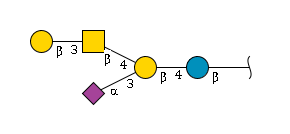
term (main_entry) : GM1
glycan_dictionary_accession : GSD000091
glytoucan_accession : G48558GR
term_in_sentence : GM1-induced fluidization of the phospholipid membranes and probable physical contact between bulky sugar head group of GM1 and spectrin, may explain the modulatory role of GM1 on aminophospholipid interactions with nonerythroid brain spectrin.[PMID: 29920238]
publication : 18524657|31761138|36180805|29920238|33859490|31937438|25762012|25931034|31776384|32013258|30776097|31048748|31447771|30292198|28796418|27806275|21076871|27552916|17986147|26960162|27815022|25851126|32916822|11462671|28236574|15911874|28577204|28497346|1794005|31934908|30267299|16902585|29439846|32325905|29747823|27576485|26338710|27858734|24501414|26818965|26629687|26958633|1854596|32134593|32198666|6619101
definition : A branched amino pentasaccharide consisting of the linear sequence β-D-Gal-(1→3)-β-D-GalNAc-(1→4)-β-D-Gal-(1→4)-β-D-Glc having a Neu5Ac residue attached to the inner galactose via an α-(2→3) linkage. The oligosaccharide of ganglioside GM1a.[CHEBI:59208]
term_xref : GlycoMotif:GGM.000098|GTC:G48558GR|CID:196569|CHEBI:59208|GlycoEpitope:EP0050|SugarBind_Ligand:13|KEGG:G00110
synonyms : GM1 ganglioside|GM1-ganglioside
function : The branched pentasaccharide chain of ganglioside GM1 is a prominent cell surface ligand, for example, for cholera toxin or tumor growth-regulatory homodimeric galectins.[PMID:16267866]
disease_associations : GM1 gangliosidosis (GM1) [PMID: 33859490]|Gastroenteritis[SugarBind_Ligand:13]|Actinomycosis[SugarBind_Ligand:13]|Lazy leukocyte syndrome[SugarBind_Ligand:13]|Toxoplasmosis[SugarBind_Ligand:13]|Cholera[SugarBind_Ligand:13]|Botulism[SugarBind_Ligand:13]
wikipedia : https://en.wikipedia.org/wiki/GM1
essentials_of_glycobiology : Chapter 11| Chapter 14
GM2
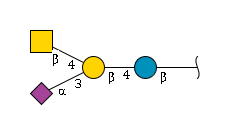
term (main_entry) : GM2
glycan_dictionary_accession : GSD000092
glytoucan_accession : G79389NT
term_in_sentence : GM1 gangliosidosis has both central nervous system and systemic findings; while, GM2 gangliosidosis is restricted primarily to the central nervous system.[PMID: 27491214]
publication : 29618308|27491214|32867370|30030044|27499644|31097363|29100724|27402091|31852956|30389374|30988135|8786814|14533808|23370522|28192816|32692591|29106755|28833537|11339652|9728335|27270764|9714704|26175473|27018595|28615102|28974375|32951593|11462672|28955902|17192692|26538065|25421609|9572057|11596983|15264019|23236285|11596984|31261761|30113798|24391178|24309906|22224667|7980537|18272501|9006924|
definition : A branched amino tetrasaccharide consisting of the linear sequence β-D-GalNAc-(1→4)-β-D-Gal-(1→4)-β-D-Glc having a Neu5Ac residue attached to the galactose via an α-(2→3) linkage. Corresponds to the carbohydrate portion of ganglioside GM2.[CHEBI:59220]
term_xref : GlycoMotif:GGM.000095|GTC:G79389NT|CID:45266845|CHEBI:59220|GlycoEpitope:EP0051|SugarBind_Ligand:39|KEGG:G00109|KEGG:G10351
synonyms :
function :
disease_associations : lung adenocarcinoma[GlycoEpitope:EP0051]|embryonal carcinoma[GlycoEpitope:EP0051]|germ cell tumor[GlycoEpitope:EP0051]|teratocarcinoma[GlycoEpitope:EP0051]|squamous cell carcinoma[GlycoEpitope:EP0051]|Gastroenteritis[SugarBind_Ligand:39]|Cholera[SugarBind_Ligand:39]|Clostridial myonecrosis[SugarBind_Ligand:39]|Tetanus[SugarBind_Ligand:39]
wikipedia : https://en.wikipedia.org/wiki/GM1_gangliosidoses
essentials_of_glycobiology : Chapter 11
GM3

term (main_entry) : GM3
glycan_dictionary_accession : GSD000093
glytoucan_accession : G91237TK
term_in_sentence : We also demonstrated an essential role of GM3 in murine and human auditory systems; a common pathological feature of GM3S deficiency is deafness. [PMID: 29747813]
publication : 29376491|29747813|25613425|30318083|31526872|31004109|28019668|26434718|27313500|27539856|30111401|28544772|29407985|19364317|30190430|31297734|30091781|26043887|32183071|30665141|27873002|25801320|30209782|32378734|23050851|22768242|14993837|24934090|17638075|21518140|26102277|19759399|24502144|25303960|23564406|16636105|16491123|11259118|15102521|12724312|24985965|8496625|25403557|15690123|15939439|25893133|23591593|20634908|2004380|739008|
definition : Ganglioside GM3 (d18:1/16:0) is a glycosphingolipid (ceramide and oligosaccharide)or oligoglycosylceramide with one or more sialic acids (i.e. n-acetylneuraminic acid) linked on the sugar chain. It is a component the cell plasma membrane which modulates cell signal transduction events. Gangliosides have been found to be highly important in immunology. Ganglioside GM3 carries a net-negative charge at pH 7.0 and is acidic. Gangliosides can amount to 6% of the weight of lipids from brain, but they are found at low levels in all animal tissuesGangliosides are glycosphingolipids. There are four types of glycosphingolipids, the cerebrosides, sulfatides, globosides and gangliosides. Gangliosides are very similar to globosides except that they also contain N-acetyl neuraminic acid (NANA) in varying amounts. The specific names for the gangliosides provide information about their structure. The letter G refers to ganglioside, and the subscripts M, D, T and Q indicate that the molecule contains mono-, di-, tri and quatra-sialic acid. The numbered subscripts 1, 2 and 3 refer to the carbohydrate sequence that is attached to the ceramide. In particular, 1 stands for GalGalNAcGalGlc-ceramide, 2 stands for GalNAcGalGlc-ceramide and 3 stands for GalGlc-ceramide. Deficiencies in lysosomal enzymes that degrade the carbohydrate portions of various gangliosides are responsible for a number of lysosomal storage diseases such as Tay-Sachs disease, Sandhoff disease, and GM1 gangliosidosis. The carbohydrate portion of the ganglioside GM1 is the site of attachment of cholera toxin, the protein secreted by Vibrio cholerae.[HMDB0004844]
term_xref : GlycoMotif:GGM.000090|GTC:G91237TK|CID:5288424|CHEBI:59226|GlycoEpitope:EP0053|SugarBind_Ligand:35
synonyms :
function : Membrane stabilizer|Energy source|Energy storage|Molecular messenger:|Signaling molecule[HMDB0004844]
disease_associations : Gastroenteritis[SugarBind_Ligand:35]|Chronic gastritis[SugarBind_Ligand:35]|Toxoplasmosis[SugarBind_Ligand:35]|Peptic ulcerSugarBind_Ligand:35]|Gastric cancer[SugarBind_Ligand:35]|Influenza[SugarBind_Ligand:35]|Diarrhea[SugarBind_Ligand:35]|Botulism[SugarBind_Ligand:35]
wikipedia :
essentials_of_glycobiology : Chapter 37
GM4

term (main_entry) : GM4
glycan_dictionary_accession : GSD000094
glytoucan_accession : G30207PZ
term_in_sentence : GM4 is synthesized by the sialylation of galactosylceramide (GalCer), while the ganglioside GM3 is synthesized by the sialylation of lactosylceramide (LacCer).[PMID:23999868]
publication : 23999868|2332419|12091485|19542236|8407875|23320941|28808804|3621237|23203271|7057115|26362868|6170387|18034482|7076644|2391348|25464080|3701369|11217952|6201236|30744426|9388026|27177620|30246056|15979459|7586078|6779816|29402905|7335153|3306476|17499534|7074082|9668345|3701884|26862430|6831238|27311552|26831445|24417799|7097284|4169231|16854400|26483798
definition : An amino disaccharide consisting of β-D-galactose having an α-N-acetylneuraminyl residue attached at the 3-position [CHEBI:63155]
term_xref : GlycoMotif:GGM.000089|GTC:G30207PZ|CID:5289366|CHEBI:63155|KEGG:G00317|SugarBind_Ligand:110
synonyms : Sialylated GalCer
function :
disease_associations : Chronic gastritis[SugarBind_Ligand:110]|Peptic ulcers[SugarBind_Ligand:110]|Gastric cancer[SugarBind_Ligand:110]
wikipedia :
essentials_of_glycobiology : Chapter 11|Chapter 15|Chapter 44|Appendix 45A
GP1c
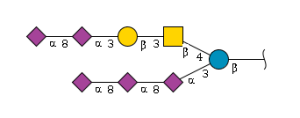
term (main_entry) : GP1c
glycan_dictionary_accession : GSD000095
glytoucan_accession : G93805MV
term_in_sentence : n this report, we describe an efficient convergent synthesis of the GP1c glycolipid epitope, which is one of the most complex c-series gangliosides. [PMID:19053458]
publication : [https://pubmed.ncbi.nlm.nih.gov/[https://pubmed.ncbi.nlm.nih.gov/1606358 1606358 1606358] [https://pubmed.ncbi.nlm.nih.gov/1606358 1606358 1606358]]|19053458|[https://pubmed.ncbi.nlm.nih.gov/1695858 1695858 1695858]|4091974|10775425|[https://pubmed.ncbi.nlm.nih.gov/2468656 2468656 2468656]|[https://pubmed.ncbi.nlm.nih.gov/2299350 2299350 2299350]|3064875|11432974|[https://pubmed.ncbi.nlm.nih.gov/[https://pubmed.ncbi.nlm.nih.gov/9613831 9613831 9613831] [https://pubmed.ncbi.nlm.nih.gov/9613831 9613831 9613831]]|11831845|1879553|[https://pubmed.ncbi.nlm.nih.gov/[https://pubmed.ncbi.nlm.nih.gov/10699494 10699494 10699494] [https://pubmed.ncbi.nlm.nih.gov/10699494 10699494 10699494]]|8969459|[https://pubmed.ncbi.nlm.nih.gov/[https://pubmed.ncbi.nlm.nih.gov/8474578 8474578 8474578] [https://pubmed.ncbi.nlm.nih.gov/8474578 8474578 8474578]]|[https://pubmed.ncbi.nlm.nih.gov/12031286 12031286 12031286]|1304332|[https://pubmed.ncbi.nlm.nih.gov/9153001 9153001 9153001]|[https://pubmed.ncbi.nlm.nih.gov/[https://pubmed.ncbi.nlm.nih.gov/10564776 10564776 10564776] [https://pubmed.ncbi.nlm.nih.gov/10564776 10564776 10564776]]
definition :
term_xref : GlycoMotif:GGM.000118|GTC:G93805MV
synonyms :
function :
disease_associations :
wikipedia :
essentials_of_glycobiology : Chapter 11|Chapter 14|Chapter 27|Chapter 35|Chapter 45 |Chapter 47|Chapter 49
GQ1b
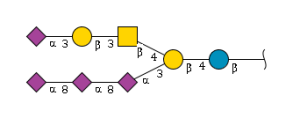
term (main_entry) : GQ1b
glycan_dictionary_accession : GSD000096
glytoucan_accession : G18625KA
term_in_sentence : Bilateral infusion of GQ1b into the hippocampus ameliorates cognitive deficits in the triple-transgenic AD mouse model (3xTg-AD).[PMID:31186474]
publication : 30798387|31186474|26704905|23677659|26984947|24184316| 23804237|9819299|18514410|22189683|24859332
definition : An amino oligosaccharide that is a branched octasaccharide derivative consisting of four sialyl residues, two galactose residues, one N-acetylglucosamine and a glucose residue at the reducing end.[CHEBI:59212]
term_xref : GlycoMotif:GGM.000115|GTC:G18625KA|GlycoEpitope:EP0069|CID:45266843|KEGG:G00117|CHEBI:59212
synonyms :
function :
disease_associations :
wikipedia :
essentials_of_glycobiology : Chapter 11
GQ1ba
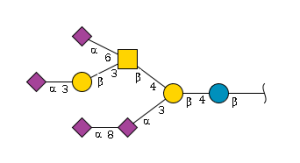
term (main_entry) : GQ1ba
glycan_dictionary_accession : GSD000097
glytoucan_accession : G54733XO
term_in_sentence : A few studies have reported the association of autoantibodies to GM1 or GQ1bα with Alzheimer's disease (AD) or vascular dementia.[PMID:25024341]
publication : 25024341|23717411|17870542|10702226|21137678|26748510|8662799|21274438|24649890|16580208|28124591|20095613|17507233|23565921|14505645|20930939|9201997
definition :
term_xref : GlycoMotif:GGM.000116|GTC:G54733XO
synonyms : GQ1balpha
function :
disease_associations :
wikipedia :
essentials_of_glycobiology :
GQ1c
term (main_entry) : GQ1c
glycan_dictionary_accession : GSD000098
glytoucan_accession : G99524KA
term_in_sentence : The neural specific monoclonal antibody A2B5 was found to interact with GQ1c but not with Gq1b, nor did it interact with other glycolipids such as GM1, GD1a, GD1b, GT1a, GT1b and GA1.[PMID: 6640289]
publication : 6640289|[https://pubmed.ncbi.nlm.nih.gov/1695858 1695858 1695858]|[https://pubmed.ncbi.nlm.nih.gov/7798936 7798936 7798936]|1729139|[https://pubmed.ncbi.nlm.nih.gov/2468656 2468656 2468656]|20368669|[https://pubmed.ncbi.nlm.nih.gov/2723647 2723647 2723647]|1814411|3064875|6085330|[https://pubmed.ncbi.nlm.nih.gov/1613492 1613492 1613492]|17883393|11831845|10775425|8219015|8804704|1384262|[https://pubmed.ncbi.nlm.nih.gov/7066685 7066685 7066685]|2299192|[https://pubmed.ncbi.nlm.nih.gov/9613831 9613831 9613831]|10350354|1304337|9153001|11959025|[https://pubmed.ncbi.nlm.nih.gov/8474578 8474578 8474578]|2299350|[https://pubmed.ncbi.nlm.nih.gov/10564776 10564776 10564776]|[https://pubmed.ncbi.nlm.nih.gov/10699494 10699494 10699494]|3942818|12031286|[https://pubmed.ncbi.nlm.nih.gov/7361620 7361620 7361620]
definition : Alpha-Neu5Ac-(2->8)-alpha-Neu5Ac-(2->8)-alpha-Neu5Ac-(2->3)-[alpha-Neu5Ac-(2->3)-beta-D-Galp-(1->3)-beta-D-GalpNAc-(1->4)]-beta-D-Galp-(1->4)-beta-D-Glcp is a member of neuraminic acids and an amino octasaccharide.[CID:91860352]
term_xref : GlycoMotif:GGM.000117|GTC:G99524KA|CID:91860352|CHEBI:145645|KEGG:G00121
synonyms :
function :
disease_associations :
wikipedia :
essentials_of_glycobiology : Chapter 46
GT1a
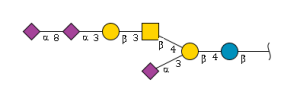
term (main_entry) : GT1a
glycan_dictionary_accession : GSD000099
glytoucan_accession : G68110IF
term_in_sentence : GT1a mimicry was found in the lipo-oligosaccharides of strain ICDCCJ07002 and ICDCCJ07004; but a combination of GM3/GD3 mimics was observed in ICDCCJ07001, although this patient had anti-GT1a IgG antibodies.[PMID:26197476]
publication : 12023422|32623212|26197476|9585812|29747820|23804237|11993188|31683059|19631994|9742882|29709941|8971119|8706663|893404|31829433|8910600|30600291|29319803|26176883|29063860|6766128|31602715|29808463|30711390|29847988|30116054|28187751
definition : A branched heptasaccharide derivative consisting of three sialyl residues, two galactose residues, one N-acetylglucosamine and a glucose residue at the reducing end.[CHEBI:59215]
term_xref : CID:45266863|GlycoMotif:GGM.000110|GTC:G68110IF|GlycoEpitope:EP0066|KEGG:G00112|CHEBI:59215
synonyms :
function :
disease_associations :
wikipedia :
essentials_of_glycobiology :
GT1a alpha
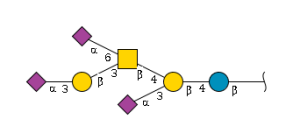
term (main_entry) : GT1a alpha
glycan_dictionary_accession : GSD000100
glytoucan_accession : G02149VR
term_in_sentence : A new class of gangliosides, GT1a alpha and GQ1b alpha, were initially identified as cholinergic neuron-specific antigens in bovine brain. [PMID:8082783]
publication : 7710562|8082783|10972137|9468624|9143254|8221098|9679279|11368158|11878808
definition :
term_xref : GlycoMotif:GGM.000111|GTC:G02149VR|GlycoEpitope:EP0111|CID:91851751|CHEBI:156678|KEGG:G00128
synonyms : GT1aa
function : GT1a alpha was a cholinerginic-specific antigen.[GlycoEpitope:EP0111]
disease_associations :
wikipedia :
essentials_of_glycobiology :
GT1b
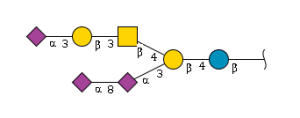
term (main_entry) : GT1b
glycan_dictionary_accession : GSD000101
glytoucan_accession : G40183QN
term_in_sentence : GT1b ganglioside is axonally transported to the spinal cord dorsal horn and contributes to characteristics of neuropathic pain such as mechanical and thermal hypersensitivity.[PMID: 32030804]
publication : 32030804|26370787|32046393|9712688|7636307|9931455|25520869|19605473|17188834|10233751|22735313|20540782|22746533|1861141|19490186|9521848|11921200|10731661|31431523|15274627|32726962|12573517|18277613|11370834|11234774|11123278|18704164|16291967|11411041|27549393|25253868|22720883|10686582|11511306|29904724|31472390|19156870
definition : A branched amino heptasaccharide comprising a β-D-galactosyl-(1→4)-β-D-glucose disaccharide, the galactosyl residue of which carries an N-acetyl-α-neuraminyl-(2→3)-β-D-galactosyl-(1→3)-N-acetyl-β-D-galactosaminyl trisaccharide unit and an N-acetyl-α-neuraminyl-(2→8)-N-acetyl-α-neuraminyl disaccharide unit through (2→4) and (2→3) linkages respectively. It corresponds to the carbohydrate portion of ganglioside GT1b.[CHEBI:59225]
term_xref : GlycoMotif:GGM.000112|GTC:G40183QN|GlycoEpitopeEP0067|CID:45266781|CHEBI:59225| GlycoGlycoEpitope:130680|SugarBind_Ligand:26|KEGG:G00116
synonyms :
function :
disease_associations : Toxoplasmosis[SugarBind_Ligand:26]|Lyme disease[SugarBind_Ligand:26]|Cholera[SugarBind_Ligand:26]|Botulism[SugarBind_Ligand:26]|Tetanus[SugarBind_Ligand:26]|Influenza[SugarBind_Ligand:26]
wikipedia :
essentials_of_glycobiology :
GT1c
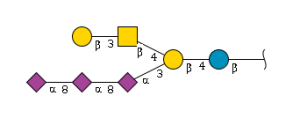
term (main_entry) : GT1c
glycan_dictionary_accession : GSD000102
glytoucan_accession : G78818SP
term_in_sentence : We show here that VVH associates with ganglioside GM1a, Fucosyl-GM1, GD1a, GT1c, and GD1b by glycan array.[PMID: 32228455]
publication : 28088450|30085356|32228455|2468656|19841910|23877172|1695858|10564776|1613492|8474578|7798936|11180643|2723647|7066685|9613831|7361620|10699494
definition : A branched amino heptasaccharide consisting of a linear tetrasaccharide of β-D-galactose, N-acetyl-β-D-galactosamine, β-D-galactose and β-D-glucose residues linked sequentially (1→3), (1→4) and (1→4), to the galactose residue proximal to the reducing end is also linked (2→3) an N-acetyl-α-neuraminyl-(2→8)-N-acetyl-α-neuraminyl-(2→8)-N-acetyl-α-neuraminyl trisaccharide side-chain. The carbohydrate moiety of ganglioside GT1c.[CHEBI:90509]
term_xref : GlycoMotif:GGM.000113|GTC:G78818SP|CID:91846734|CHEBI:90509|GlycoEpitope:EP0033|KEGG:G00120
synonyms :
function :
disease_associations :
wikipedia :
essentials_of_glycobiology :
GT2
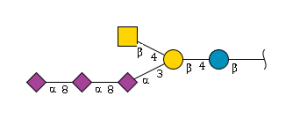
term (main_entry) : GT2
glycan_dictionary_accession : GSD000103
glytoucan_accession : G36476BA
term_in_sentence : Biosynthesis of the c-series gangliosides GT3, GT2 and GP1c was studied in Golgi derived from rat liver.[PMID: 1606358]
publication : 1606358|15498585|16005859|27540730|31533196|31201844
definition : A branched amino hexasaccharide consisting of a chain of three α-sialyl residues, a β-D-galactosyl residue and a β-D-glucose residue linked sequentially (2→8), (2→8), (2→3) and (1→4), to the galactosyl residue of which is also linked (1→4) an N-acetyl-β-D-galactosaminyl residue. The carbohydrate moiety of ganglioside GT2.[CHEBI:72446]
term_xref : GlycoMotif:GGM.000109|GTC:G36476BA|CID:70788971|CHEBI:72446|KEGG:G00119
synonyms :
function :
disease_associations :
wikipedia :
essentials_of_glycobiology : Chapter 11
GT3

term (main_entry) : GT3
glycan_dictionary_accession : GSD000104
glytoucan_accession : G93899SO
term_in_sentence : The purpose of this study was two-fold: (1) to formulate γ-tocotrienol (GT3) in a nanoemulsion formulation as a prophylactic orally administered radioprotective agent; and (2) to optimize the storage conditions to preserve the structural integrity of both the formulation and the compound.[PMID: 28029115]
publication : 28029115|31355968|30987413|27869747|27216753|8631981|29672891|10385047|29642403|10412028|27193023|30068561|23415908|8858920|2303428|27153057|27128741|2654294|26930378|7561885|25860286|30845647|24712339|30070965|8910600|[https://pubmed.ncbi.nlm.nih.gov/1606358 1606358 1606358]|27356050|8514740|18509108|23000517|29769046|29566611
definition : A linear amino pentasaccharide consisting of a chain of three α-sialyl residues, a β-D-galactosyl residue and a β-D-glucose residue linked sequentially (2→8), (2→8), (2→3) and (1→4).[CHEBI:72444]
term_xref : GlycoEpitope:EP0070|KEGG:G00118|CID:70788970|GlycoMotif:GGM.000092|GTC:G93899SO|CHEBI:72444
synonyms :
function :
disease_associations :
wikipedia :
essentials_of_glycobiology : Chapter 11